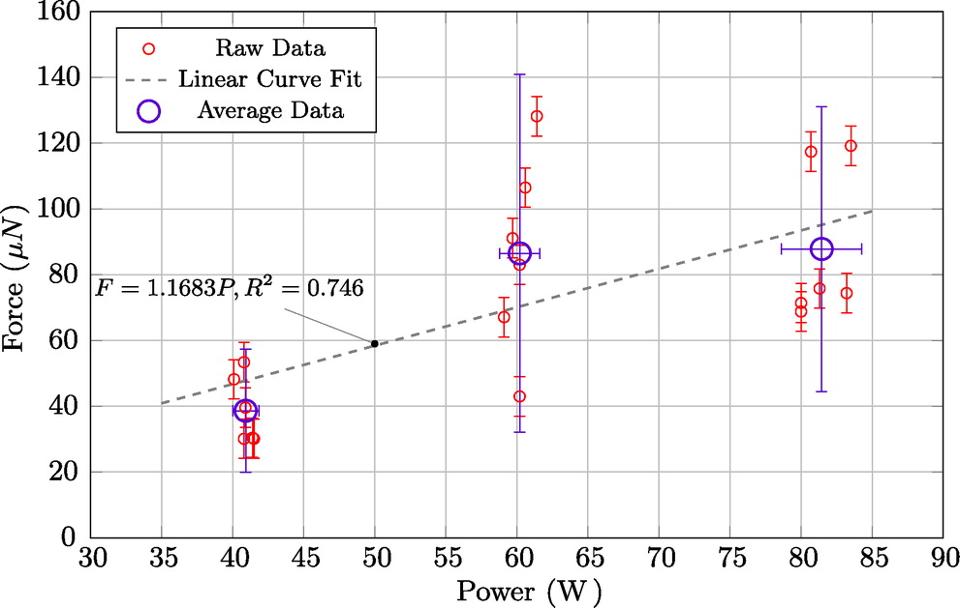So, there is now a peer-reviewed paper on the fabled EmDrive, which empirically measured a statistically significant thrust. The important results are in Figure 19 up above, and here is what the paper has to say about it:
Figure 19 presents a collection of all the empirically collected data. The averaging of the forward and reverse thrust data is presented in the form of circles. A linear curve is fitted to the data and is shown with the corresponding fitted equation. The vacuum test data collected show a consistent performance of 1.2±0.1uN/kW
It’s not clear if the fit was to the averaged data or the raw data. I suspect the averaged, because looking at the raw data, at no time did thrust exceed 130 uN, even when power was increased from 60 to 80 kW. In fact the data at 80 kW points averages out to the same thrust as at 60 kW, and the error bars are a textbook example of the difference between accuracy and precision.
These results are peer-reviewed, and there is a “statistically significant” linear fit to the data that does demonstrate a correlation between the input power and the observed thrust, but this data does not show that the EmDrive actually works. As Chris Lee at Ars Technica put it, the drive still generates more noise than thrust:
The more important point is that the individual uncertainties in their instrumentation don’t account for the variation in the thrust that they measure, which is a very strong hint that there is an uncontrolled experimental parameter playing havoc with their measurements.
Lee also points out that there are a lot of experimental questions left unanswered, including:
- Why are there only 18 data points for an experiment that only takes a few minutes to perform?
- Where is the data related to tuning the microwave frequency for the resonance chamber, and showing the difference between on-resonance mode and an adjacent mode?
- What is the rise-time of the amplifier?
- What is the resonance frequency of the pendulum?
on that last point, Lee elaborates:
The use of a pendulum also suggests the sort of experiment that would, again, amplify the signal. Since the pendulum has a resonance frequency, the authors could have used that as a filter. As you modulate the microwave amplifier’s power, the thrust (and any thermal effects) would also be modulated. But thermal effects are subject to a time constant that smears out the oscillation. So as the modulation frequency sweeps through the resonance frequency of the torsion pendulum, the amplitude of motion should greatly increase. However, the thermal response will be averaged over the whole cycle and disappear (well, mostly).
I know that every engineer and physicist in the world knows this technique, so the fact that it wasn’t used here tells us how fragile these results really are.
This is really at the limit of my empirical understanding, but it’s a question that the authors of the paper (not to mention anyone over at /r/emdrive) should be able to field with no worries.
Basically, this paper doesn’t answer any of the substantive questions. But it does at least validate the notion that there is something going on worth investigating. But let’s be real about the outcome – because we’ve seen this before:
For faster-than-light neutrinos, it was a loose cable. For the BICEP2 results, it was an incorrect calibration of galactic gas. For cold fusion, it was a poor experimental setup, and for perpetual motion, it was a scam. No matter what the outcome, there’s something to be learned from further investigation.
and that’s why we do science. It’s not as if scientists are fat cats out to protect their cash cow. (Seriously. I wish it were so). Maybe we are on the verge of another breakthrough, but it will take a lot more than this paper to convince anyone. And that’s as it should be.

